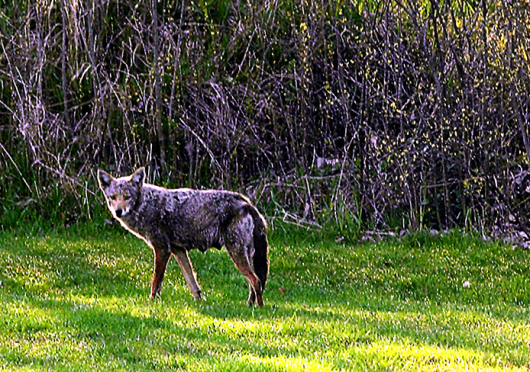
Some wildlife specialists say that coyote populations living in urban areas like Columbus feel at home in these places. Credit: Courtesy of TNS
At Ohio State, wildlife isn’t so wild anymore. In fact, one wildlife expert said some animals, like coyotes, already call OSU home.
“There are coyotes that go through the OSU campus,” said Stan Gehrt, associate professor and wildlife extension specialist at Ohio State’s College of Food, Agricultural and Environmental Sciences. “They’re already in Columbus. The rivers by (State Route) 315 are natural corridors for coyotes to move through, so people see them there all the time.”
Gehrt studies the coyote population living in urban areas, and said some of these animals are at home in urban areas like those surrounding OSU.
Gehrt said he started researching the urban ecology of different wildlife species in Chicago before coming to OSU.
“When I was (in Chicago), coyotes had emerged where they hadn’t been before,” Gehrt said. “A lot of people were interested in what that meant since coyotes are predators.”
Coyotes began to move into urban areas beginning in the late 1980s, Gehrt said.
“The coyote population grew dramatically, and as it grows, young coyotes are forced into different habitats,” he said. “Once they moved, they found cities to be a favorable habitat, but they had to share it with so many people.”
The expansion of the coyote population isn’t limited to the city, though.
Glenn Mills, the farm manager at Waterman Agriculture and Natural Resources Laboratory Complex, located off of Kenny Road on West Campus, said he often sees coyotes throughout the day.
“When I’m harvesting corn, they shadow me the whole day and wait for me to scare out the rabbits, rats and mice,” Mills said. “They’re kind of a welcome sight. They remove the rats, mice and rabbits that we do have problems with.”
Although Mills said he appreciates the coyotes at the Laboratory Complex, the animals are not considered welcome guests at Waterman dairy farm.
“The dairy farm has had issues with them,” he said. “They had a bunch of cats, and the coyotes were going into the barn and eating the cats.”
Although coyotes are predators, they’re not prone to attack domestic animals, Gehrt said.
“What people don’t realize is that coyotes don’t have interest in dogs,” he said. “They try to avoid people or dogs.”
Coyote attacks can occur for a variety of reasons, though they are rare, Gehrt said.
“It’s actually an exception to the rule when coyotes attack a dog. During this time of year they’ll start having litters, and it’s when we have an increase in attacks because dogs accidentally run into their dens,” he said. “They’re not just attacking dogs, they’re trying to defend their litters.”
However, dog owners should implement cautionary measures if they live in an area with a coyote population, Gehrt said.
“Within their yard, (dog owners) should be aware if coyotes are living near them,” he said. “If they have outdoor dogs or other pets, they need to manage food they would normally leave out overnight because now there are coyotes living in the area. They need to take the food in at night so they’re not inadvertently feeding coyotes.”
In the instance in which a person encounters a coyote, he or she shouldn’t run away, Gehrt said.
“People should always act aggressive toward them: yell at them, wave their arms, blow a whistle,” he said. “Make noise and take a few steps toward them because that’s a threatening move, and the coyote should run away.”
Mills said the Columbus coyote population probably will fluctuate throughout the year.
“Coyotes in Columbus are transient,” Mills said. “They come, and they’ll be here for a while. They usually come and go.”


